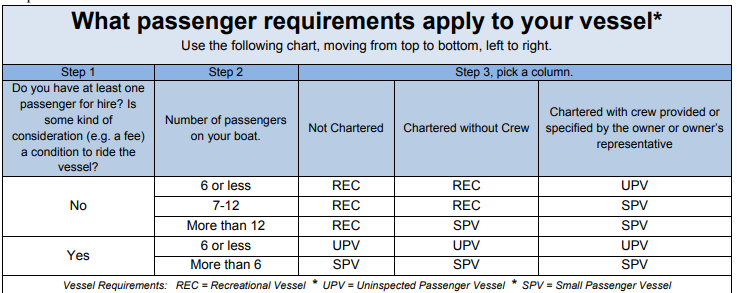
Carrying Passengers on Your Boat…Legally?
Have you taken passengers for rides on your boat and charged a fee or are you thinking about it? Are you considering renting out your boat to make money? Federal law requires passenger for hire service operating on U.S. navigable waters to comply with minimum federal safety and personnel licensing laws and regulations.
A violation of these laws can result in fines of up to $42,750 or more per day. Repeated violations or an accident leading to injury or death on non-compliant vessels can lead to felony criminal charges. The term “charter” or charter boat is often misused. A charter in the maritime realm is a legal term going back to the days of sail. Today, a chartered vessel is like a rented vessel where an individual assumes responsibilities as its owner, similar to when you rent a car or a houseboat. A written agreement is signed whereupon the renter (charterer) takes on ownership responsibilities from the vessel’s true owner.
The charterer is responsible for all materials to operate it (the crew, insurance, fuel, stores, etc.). This can be categorized as a vessel “chartered without crew”, also referred to as a bareboat charter. In some cases the true owner of the vessel designates specifically who operates their vessel when it’s under charter. This is known as “chartered with crew”. If you are the true owner of the vessel and operate it, this is a non-chartered vessel.
These circumstances represent 3 important vessel categories:
(1) Not Chartered,
(2) Chartered without Crew,
(3) Charted with Crew. Use the following chart to find your requirements.
Requirements can be found in USCG NVIC 07-94, 46 USC 2101 and http://www.uscgboating.org/ . You’ll also need to check local and state requirements. USCG licenses are required for UPVs and SPVs. Active USCG Inspections and a Certificate of Inspection are required for a SPV. *This table represents common motorized vessels under a 100 gross regulatory tonnage size. Other special circumstances exist. Vessels on a scheduled route (ferries) carrying more than 6 people (even for free) must meet SPV requirements. Non motorized/non self propelled vessels carrying 6 or less paying passenger(s) need only meet REC requirements; when carrying over 6 passengers for hire, the vessel must meet SPV requirements.
Vessels 100 GRT and larger may carry up to 12 passengers for hire as a UPV. A submersible (submarine like) vessel carrying just one or more paying passenger is classified as a SPV. This is a general and simplified guide to assist in determining your vessel’s service and what laws apply. A USCG Marine Safety professional or an admiralty lawyer should be consulted for your particular circumstances.